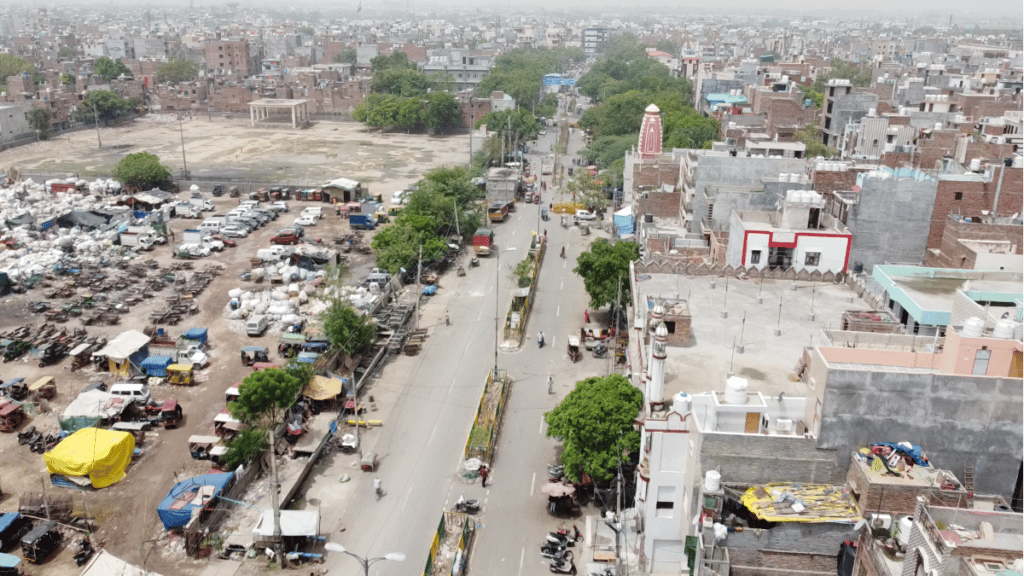Social Media’s Role in the Violence in Jahangirpuri, India
Manasa Narayanan / Dec 13, 2022Manasa Narayanan is a London-based freelance journalist reporting on politics and technology.

Last June I was in the north-Delhi locality of Jahangirpuri in India. Some weeks prior to that, religious violence broke out between Hindus and Muslims in the area. Mobs attacked each other, pelted stones, bottles and even burnt down vehicles. Nine people were injured. One officer was shot.
When I visited, almost a month and a half had passed, and I expected it would have returned to a state of normalcy. Yet when I arrived, physical remnants from the tragic day were still quite visible: destroyed and abandoned shops, a shattered car and torn down compounds.
But it wasn’t deserted– far from it. The scene was one of resilience; of people trying to build back up, but stuck in an in-between place. Many locals were still very bitter– towards the police, their ‘othered’ neighbours and, it turns out, me. They regarded me as a representative of a media system that they believe had failed them. There was also the looming presence of the state, embodied by the fairly heavy police presence camped in the area.
As a documentary filmmaker, I set out with three main questions. I wanted to find out what had unfolded on that day, what did people come to think of it, and, importantly, what was the role of social media in shaping their views?
The ecosystem of religious hate in India is a complex one. There is hate from the top-down; the continuous propagation of a narrative to the Hindu majority that asserts the Muslim minority is a threat. This is linked to various shades of hate, ranging from attempts of otherization to outright incitement of violence against Muslims.
But anti-Muslim sentiment also flows in an unpredictable, more decentralized manner through WhatsApp– characterized by historical grievances, careless forwarding of misinformation, and disinformation planted by state actors - all cemented together with the authoritarian voices from above that reinforce imagined fears. It is a recipe for hate where the prime ingredients are nationalism, religion and fanaticism. It is a case of fringe extremist voices now getting emboldened due to a combination of the silence of the majority and the active endorsement of hate by people of political influence. And adding fuel to fire, social media companies like Facebook look the other way when it comes to anti-Muslim hate speech, in what appears to be an attempt to gain political favor and protect access to the huge Indian market.
Some of the first people I approached in Jahangirpuri were a few Muslim shopkeepers. As soon as I told them I was a journalist, there was immediate distrust. Having seen themselves misrepresented and demonized in much of the media, on top of suffering terrible losses following the recent violence, their reaction was understandable. There still was a sense of fear among many who felt they would be persecuted by the police if they spoke to me on camera. They had filmed the violence on their phones. A lot of these clips were already online and playing on news channels. Did they have it on their phones and social media pages for me to see? Not anymore. The environment created in the last several years is so thorny that just the mere presence of videos on their devices might put them in a compromised position in the eyes of the state.
As I circled the area– going from one block to the next, speaking to people from both religious backgrounds– it was clear that there was no larger consensus on what unfolded. While the police are looking into the recent violence as a pre-planned conspiracy of mainly Muslim men (with some Hindu men also named in the chargesheet), whatever ‘evidence’ is publicly available for this claim is limp.
Yet, pretty soon after April’s violence, the overwhelming narrative, propagated across mainstream and alternative news and pushed on social media, was that Muslims were to blame. They were called names and painted as outsiders, such as being referred to as ‘Bangladeshi’ and ‘Rohingya’, when in fact they were born in Delhi and/or had roots to the Indian state of Bengal. This otherization came with a cost: incorrectly labelled as illegal residents, Muslim shops and businesses were razed to the ground. This needs to be seen in the larger context of bulldozer politics that has targeted Muslims in India.
While finding direct evidence of mobilization and incitement to violence on WhatsApp is a difficult task, there is no doubt that platforms like Facebook and WhatsApp are responsible for allowing hate speech and mis(dis)information to spread like wildfire. They are a key player in this web of hate. Their algorithms enable the spread of hateful content, creating and sustaining an environment ripe to spawn violence in the offline world.
In Jahangirpuri, the hate could be seen masked in ritual. It could be seen in the carrying of weapons by people in the April rally. It could be seen in the messaging of the songs being blasted on loudspeakers in front of the mosque, calling for Hindu unity and action against Muslims. It could be seen in the chants of ‘Jai Shree Ram’, a religious chant that has sadly become a call to hatred and violence.
All of this ‘celebratory’ hatred circulates freely on WhatsApp, Facebook & Instagram. It gets the blessing of the political leadership. It is propelled further by algorithms designed to serve commercial interests. And it is not acted upon because the company controlling the flow of information colludes with the ultra-nationalist party in power. And when violent incidents do occur, it is anti-minority, hateful claims that are powered through social media and messaging apps run by Western companies. This web of hate threatens to consume India, even as it delivers profits to Silicon Valley.
See Web of Hate, Manasa Narayanan’s short documentary video, here.
Authors
